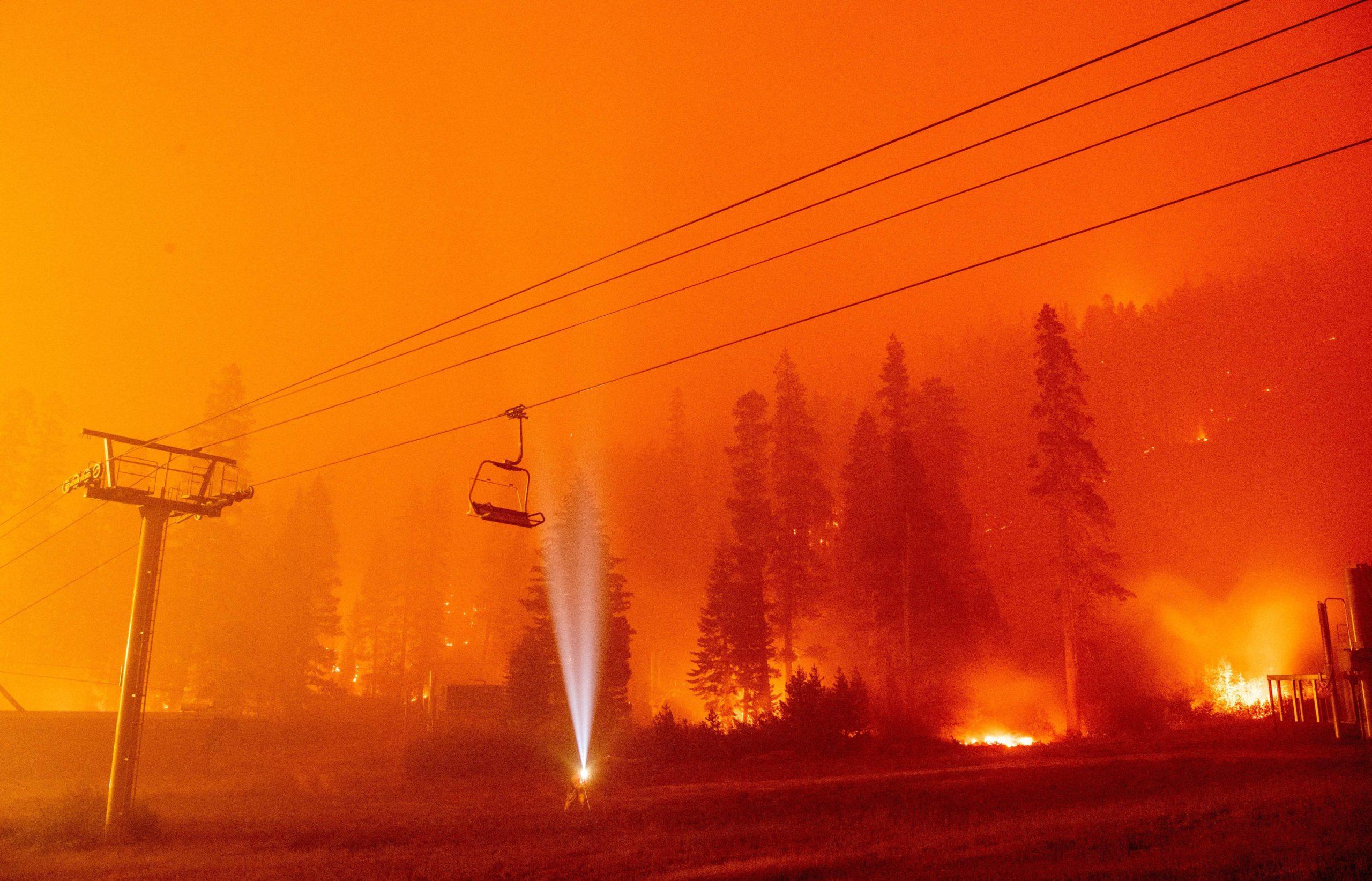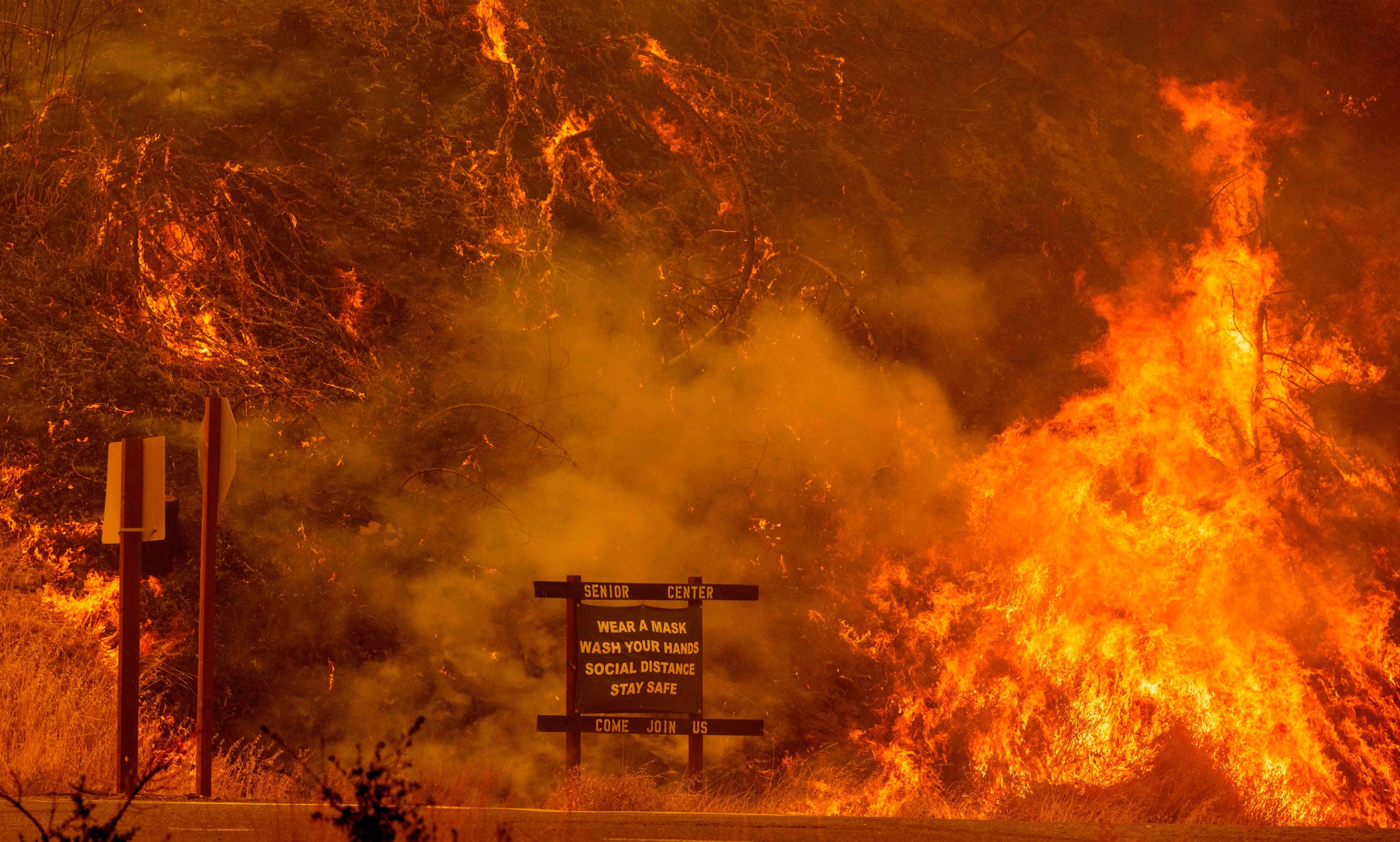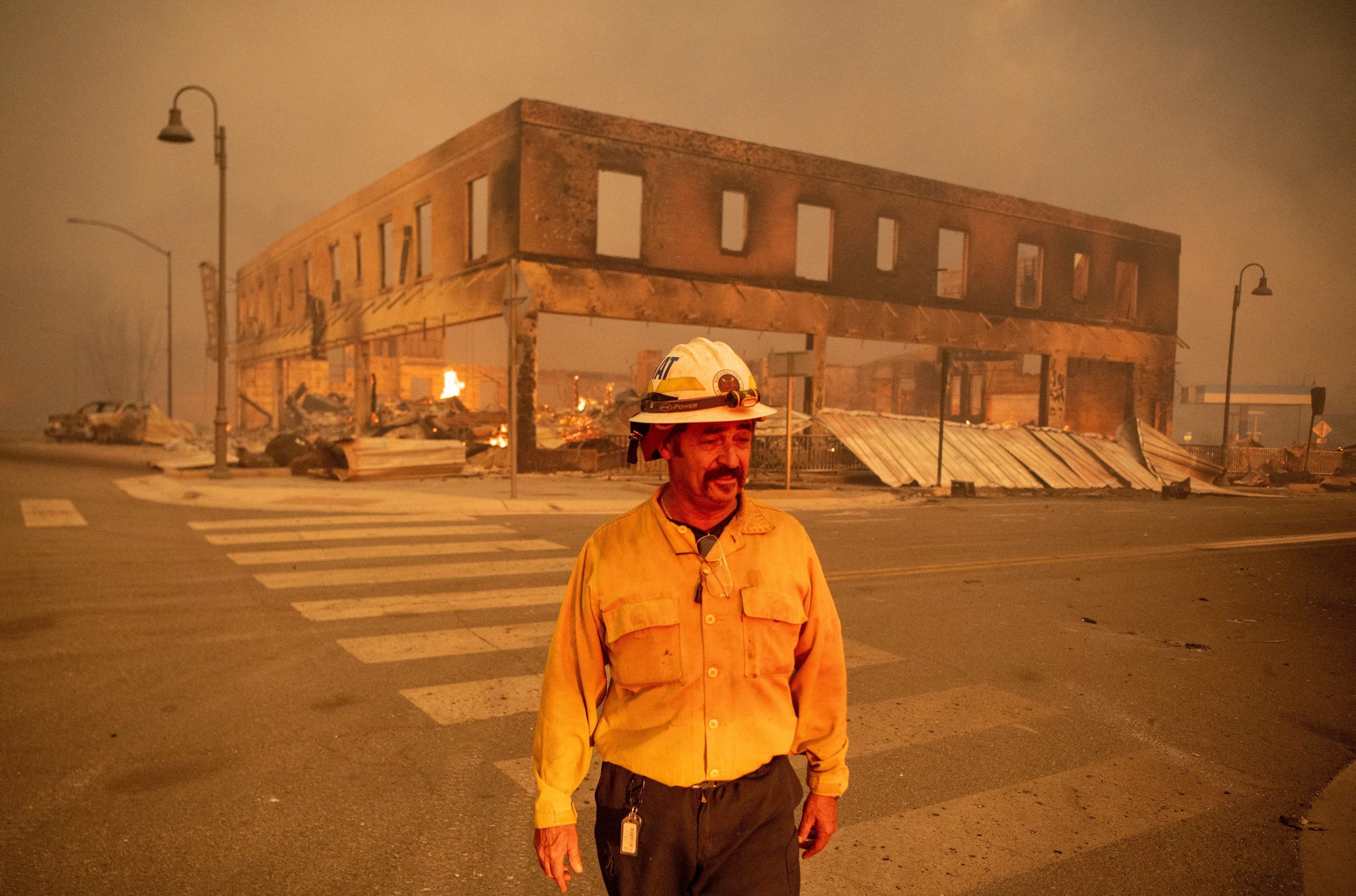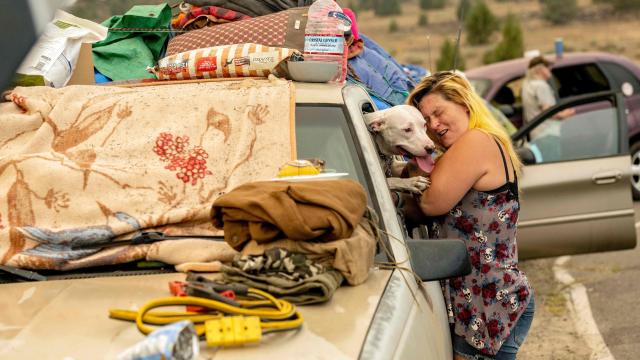The West has been primed to burn at a moment when more people than ever have moved to some of the most dangerous forests on Earth. The result has been an endless stream of horror stories and images: houses on fires, dead animals, ecosystems upended, people crying when they realise they lost everything, drone shots of neighbours completely leveled to the ground. The photographers who brave firestorms and capture moments of grief are essentially our eyes into the hellish reality for millions of people in the West.
Here at Earther, we’ve published photos from numerous wire photographers, but there’s one whose name kept popping up. Josh Edelson is a photographer whose work on Getty (care of AFP) regularly captured my eye, and the eye of photo editors, politicians, and the public around the world. Take the image at the top of this post, which Edelson shot during last year’s historic California firestorm. It graced an Earther story, was tweeted by Hillary Clinton, and turned into a meme to mock Nancy Pelosi. That photo along with a slew of other images from his wildfire coverage are finalists for the first annual Covering Climate Now awards, and the winner is slated to be announced on Wednesday.
With another brutal wildfire season roaring across the West, I wanted to know what it took to make such striking images and what Edelson hopes people take away from his work in an age where megafires have become the norm due to the climate crisis and decades of forest mismanagement. He told me about the “fire brain” that impacts him when he gets back from covering a blaze and more. Our lightly edited conversation and many, many more of his photos are below.
Brian Kahn, Earther: What got you started photographing fire?
Josh Edelson: It’s been at least 10 years, 12, maybe. I started out doing just kind of general travel and stuff. Pre-pandemic, about 75% of my workflow was corporate — corporate events, headshots, general advertising, stuff like that. In the midst of the pandemic, a lot of the corporate stuff has gone away and news has ironically become the majority of my work. I’m very passionate about covering news, and I realised in the past four or five years that I enjoy covering a protest, but where I really feel passionate is covering things related to the climate: floods, fires, and things like that. California is in a unique position, it’s the only state other than New Jersey where media is allowed to go into a disaster zone, to go virtually anywhere to cover a fire.
Earther: What is it that draws you to covering fire?
Edelson: Fire in and of itself is really fascinating. It creates its own light. It’s destructive and beautiful. It’s alive. It can go from one little smouldering patch of grass to burning an entire town. I like being able to document that process and especially be able to bring stories to people in areas where most don’t have access or they have no idea what’s going on.
Earther: What is it that makes a compelling fire image? What is a compelling way to tell the story of a fire when you’re there?
Edelson: As a journalist, the number one priority is always telling a story or show a scene in the most accurate way possible. Truth and accuracy is the number one priority. The second priority is creativity. I want to create an image that is interesting to look at. Otherwise, if someone were just out there taking snapshots [with] an iPhone, then it’s not necessarily going to generate the same type of buzz. One of the best ways to do that is to try to find something that’s like eliciting emotions.
I find that some of the most impactful photos in fires are when residents are coming back to their homes. Maybe they come back in for the first time, and they discover that they’re homeless and they’re crying and hugging themselves. That can really target the heartstrings of readers and viewers.
On the other hand, big flames tend to have that shock factor. Seeing towering flames over a fire truck or a home on fire, with firefighters trying to put it out, or in the case of Greenville, which was recently an entire town burning down, those types of things are pretty shocking. When a fire encroaches into an urban area and there are homes burning and people are affected? Suddenly, everyone’s interested. It’s like, “Oh, this could be me.”
Earther: From the perspective of someone using photos, I can say what stands out to me. Every year, whether it’s the Camp Fire in Paradise or the Carr Fire in Redding or the Caldor Fire burning near South Lake Tahoe, those are the ones that stand out to me. There were some spectacular images emerging during the Caldor Fire of a ski resort and burning cabins. Is that the kind of stuff where you’re like, “That’s the image that’s really going to hit home?” Are there images that have really stuck with you when you’ve been out there shooting recently?
Edelson: The things that really stick with me are things that are different that I’ve never seen before. I definitely never seen fire burned to the ski resort.
It was gnarly getting up there, too. It’s a long, winding road through like smoky terrain with downed trees. I didn’t know what I was going to find up there. It was really foreign, it was like an alien environment. To see a ski lift surrounded by flames really stuck with me.
The Caldor Fire in particular hit home especially hard for me because we have a family cabin in South Lake Tahoe. Usually, when I’m covering fires, I’m up there or anywhere from two to four days on average. I’m sleeping out of my car living off beef jerky and bottled water I bought at a gas station before the fire. So I’m completely self-contained, off the grid. With the Caldor Fire, I could have a bed to sleep in right in the middle of the fire zone. It was a mandatory evacuation for those cabins, but I’m media covering it so it’s a little bit different.
But there was one night in particular where I was checking all my maps on my phone and monitoring right before going to sleep around 3:00 a.m. and I noticed that there was some fire activity at what looked like right at the cabin. I get up, and there’s this deep red glow across the street. Then all of a sudden I see fire crews coming over the scanner right in that area. It’s weird, because obviously if the fire starts coming into the structure, I want to be there to shoot it. I certainly didn’t want to be vulnerable and not be able to know what was going on. So I made the hard call to come and go drive to a parking lot and then in my car for the night.

Earther: But the cabin made it?
Edelson: The fire did get close enough to where I actually hosed the cabin down and busted out a chainsaw, which I keep with me. I cut down some shrubs and trees around to do my own version of structure protection because I thought the fire was going to come right in.
Earther: I’m thousands of miles away, but it’s still striking when I see someone’s house on fire. It really affects me. When you are at that point where you can see essentially someone’s entire life or their vacation home or whatever going up in flames, how does that affect you as a photographer there to document it?
Edelson: I don’t know if it’s a healthy thing, but I feel like the camera in many ways is sort of an emotional barrier. I don’t often process everything that I experienced until after, like after I leave the fire, because the logistics of getting to a scene are so complicated that my inner monologue is so loud to capture it well.
I’m thinking where’s the fire moving? Am I safe here? Do I have an exit? Are the power lines above? Are there any trees that are about to fall? Are there propane tanks nearby? Go to 1/500th of a second, f-stop 4, ISO’s too high. Step back, the windows are going to blow out.
It’s not like you’re just standing around a campfire. It happens fast. Sometimes a home will catch fire and in 20 minutes, it’s down. Catching those moments are really challenging. Safety is obviously at the top of my mind. Also at the top of my mind is staying out of the way of firefighters.
But the emotional aspect of it often comes later for me, mostly because most of the time, it’s a kind of quiet scene when covering a fire. I tell my wife when I get home, I call it fire brain. When I come back home and my wife’s like, “Oh, I want to tell you about a conversation I had with my mother” or, “Let’s go to Whole Foods,” I can’t be in that space. I can be walking down the street and I’m looking at the buildings imagining what it’s going to look like if it was on fire or where I would stand if the trees started falling near me.

Earther: I truly can’t imagine.
Edelson: The most emotional times, at least for me, come during aftermath. Having a person pull up to a home and then find there’s nothing left in there like crying and hugging each other.
If I’m photographing a person coming home to a burned home, I always try and get some sort of at least non-verbal confirmation that they acknowledge my presence. I try not get too close. When people are crying, the last thing they want is a camera right in their face. There’s a balancing act between getting solid photos and respecting people’s privacy.
Earther: How do you balance all that and your own safety?
Edelson: I have an algorithm in my mind of how to cover fires. There are probably at least 100 rules that are just always in my mind so I can go into autopilot. It takes a lot to figure out what’s going on. I need to read the weather to understand what the weather’s doing, what the humidity is like, what the terrain is like.
I’m basically on my phone or on my computer all day or a lot leading up to making a decision on whether or not to go to a particular fire. Then on the drive, I’m listening to firefighters on a scanner, cross-referencing maps, trying to figure out where to go. So I would say probably 80 to 90 per cent of covering a wildfire is logistics and trying to put yourself in a position where you can get that peak action.

Earther: You mentioned a scanner, your phone, a chainsaw. In addition to the camera gear, what are the must-haves?
Edelson: The absolute have-to-have-it is Nomex. That’s the yellow fire suits that the firefighters wear. So that’s pants, jacket, boots, gloves, helmet, goggles, headlamp, and fire shelter. It’s like a big, bulky brick thing we have to wear on our bodies. If you’re trapped and fire is about to go over you, you pull the fire shelter up. So we always keep those on them, on us. It also kind of communicates to firefighters that, you know, we’re doing having all the appropriate gear and it communicates that they don’t have to worry about us.
Which brings me to the chainsaw. One of the things that scares me the most when covering fires is getting trapped between two felled trees in the middle of a scene where fire is approaching. If I’m driving on a road and there’s fire all around and I come to a downed tree and then I turn back, and then there’s another downed tree. That’s not a position I want to be in.
I have something called Fix-a-Flat for tires. AAA is probably not going to drive into the middle of the fire to come rescue you. Then sleeping bag, air mattress, water, and beef jerky are all the essentials that I bring with me. And also gas.
Earther: This is all a lot of work. What do you hope the public takes away after they see some of these photos and see the destruction that these fires are causing?
Edelson: It used to be that I just wanted people to see what it looked like inside the fire zones, as a matter of curiosity and fascination with nature and all that. But it’s changed with the past two to three years. With climate change like we’re well into this danger zone. With my coverage of fires, it’s changed from the story only being about that particular fire and who it affects into a broader thing. Fires are becoming more intense, and they’re not only affecting the people that are in the evacuated area. Now, they’re affecting everybody.
Nowhere is 100 per cent protected or safe from wildfires these days, and I kind of feel like everyone is responsible in a way. I feel like the responsibility falls on humans more than individual humans.
I feel like covering fires these days for me is a way of kind of being a sort of pioneer photojournalist on the climate change front. Covering wildfires didn’t used to be that, but it is now.
I often don’t know where my pictures get used or how they affect things, but I just know that the more they’re out there, the more people are talking about them, then the higher the probability chance that I played a part in helping make a change for the better.

